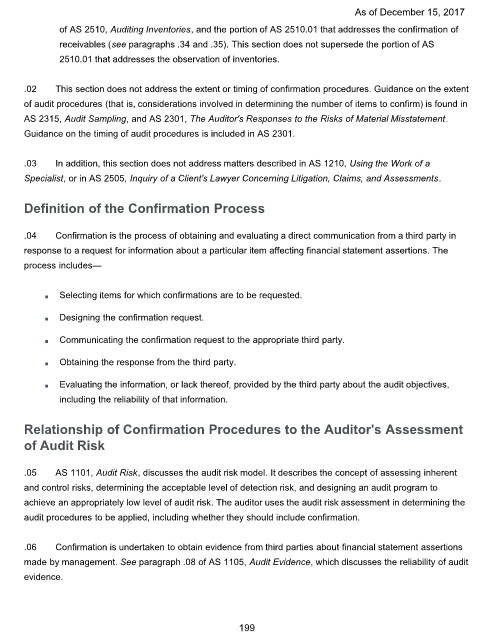Page 202 - Auditing Standards
P. 202
As of December 15, 2017
of AS 2510, Auditing Inventories, and the portion of AS 2510.01 that addresses the confirmation of
receivables (see paragraphs .34 and .35). This section does not supersede the portion of AS
2510.01 that addresses the observation of inventories.
.02 This section does not address the extent or timing of confirmation procedures. Guidance on the extent
of audit procedures (that is, considerations involved in determining the number of items to confirm) is found in
AS 2315, Audit Sampling, and AS 2301, The Auditor's Responses to the Risks of Material Misstatement.
Guidance on the timing of audit procedures is included in AS 2301.
.03 In addition, this section does not address matters described in AS 1210, Using the Work of a
Specialist, or in AS 2505, Inquiry of a Client's Lawyer Concerning Litigation, Claims, and Assessments.
Definition of the Confirmation Process
.04 Confirmation is the process of obtaining and evaluating a direct communication from a third party in
response to a request for information about a particular item affecting financial statement assertions. The
process includes—
Selecting items for which confirmations are to be requested.
Designing the confirmation request.
Communicating the confirmation request to the appropriate third party.
Obtaining the response from the third party.
Evaluating the information, or lack thereof, provided by the third party about the audit objectives,
including the reliability of that information.
Relationship of Confirmation Procedures to the Auditor's Assessment
of Audit Risk
.05 AS 1101, Audit Risk, discusses the audit risk model. It describes the concept of assessing inherent
and control risks, determining the acceptable level of detection risk, and designing an audit program to
achieve an appropriately low level of audit risk. The auditor uses the audit risk assessment in determining the
audit procedures to be applied, including whether they should include confirmation.
.06 Confirmation is undertaken to obtain evidence from third parties about financial statement assertions
made by management. See paragraph .08 of AS 1105, Audit Evidence, which discusses the reliability of audit
evidence.
199

